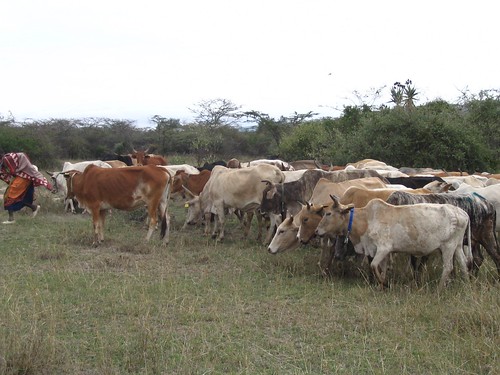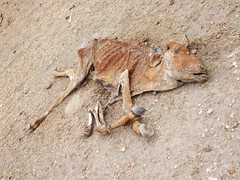Cattle fitted with tsetse-repellent dispensers suspended from neck collars were used to test the effectiveness of a prototype tsetse repellent in preventing tsetse fly bites (Photo credit: ILRI/Bett).
Recently published findings from a study done among Maasai livestock in Kenya to test whether repellents can successfully reduce tsetse fly bites in cattle show that tsetse-repellent technologies may have some success in typical field conditions but do not yet offer a viable alternative for controlling trypanosomosis in field-based livestock.
The study, ‘Field trial of a synthetic tsetse-repellent technology developed for the control of bovine trypanosomosis in Kenya,’ was the first to evaluate the use of a mobile tsetse repellent in the field. It was conducted between April 2005 and August 2006 in Nkuruman, in Kajiado District, and Nkineji, in Narok District.
Trypanosomosis is the most pervasive and serious cattle disease in sub-Saharan Africa. It kills between three and seven million cattle each year and costs farmers millions of dollars in lost production and treatment costs. The disease is transmitted mainly by blood-feeding tsetse flies that infect susceptible animals with the causative trypanosome parasite during their feeding. Other trypanosome parasites can infect humans, causing sleeping sickness, a disease that attacks the central nervous system.
Animal trypanosomosis is difficult to control because its spread is influenced by many factors, including the age, sex and colour of the cattle at risk as well as the herd size, its geographical area and climate. Adult and male cattle, for example, are more likely to contract the disease than calves and females. And tsetse flies prefer to take their feeds from animals with dark coats.
International Livestock Research Institute (ILRI) researchers Bernard Bett, Tom Randolph and John McDermott participated in the evaluation, which was designed with the help of veteran African tsetse researchers Glyn Vale and John Hargrove, and Steve Torr of Greenwich University (UK). The evaluation involved 2000 cattle: 1000 formed the control group, while the other 1000 animals were fitted with tsetse-repellent dispensers suspended from neck collars. The effectiveness of the repellent was then monitored for 16 months.
The study stipulated at the outset that the repellent would be considered effective if it reduced the incidence of trypanosomosis by 50 percent or more in the repellent-treated animals versus the control animals. Failure to achieve this level of reduction would mean that the repellent technology was clearly not ‘a viable alternative to existing control techniques’.
Results from the trial showed that the technology reduces trypanosomosis infection rates only modestly. ‘The synthetic repellent reduced the incidence of the disease only by 18 percent,’ said Bett, the ILRI scientist who implemented the trial.
Bett went on to explain that the technology had been proposed for evaluation based on initial experiments using stationary cattle that suggested that the repellents could reduce infection rates by more than 80 percent. ‘Under typical field conditions, however,’ said Bett, ‘the repellent did not provide adequate levels of protection, so we are recommending that it not be considered for further commercial development at this point.’
That the effectiveness of the repellent in the field was lower than expected could be attributed to both the fragile nature of the repellent dispensers, which, sensitive to abrasions, often leaked, as well as the repellent itself. Tsetse flies, especially hungry ones, will alight even on animals that smell bad to them. This is why people, for example, whose odour should put off tsetse flies, still get bitten by them.
‘The earlier experiments might have also overestimated the benefit of the technology,’ said Bett. ‘Those initial experiments evaluated the reduction in numbers of flies feeding on tethered cattle; other flies, however, could bite quickly without feeding and still transmit the disease before the repellent drives them away. In addition, while flies mainly use odour to find a stationary cow, they use vision more than odour to guide them to moving animals, such as those in the pastoralist herds used in the field trial.’
The study found that many variables determine the effectiveness of the repellent technology. Among these are changes in grazing (during the dry season, herders tend to move their stock to pastures with higher densities of tsetse) and herd sizes (the larger the herd, the lesser are the chances that an individual animal within the herd will be bitten). Trypanosomosis incidence also differed in the two test districts. While cattle were the preferred hosts for the flies in Narok, the cattle in Kajiado came fifth in fly preference—after warthog, elephant, zebra and buffalo—which reduced the effectiveness of the repellent worn by the cattle.
Bett says that ‘the results of this study show that the tsetse-repellent technologies currently proposed are unlikely to be useful replacements of existing methods of controlling trypanosomosis.’ These include keeping indigenous ‘trypanotolerant’ cattle breeds, which can tolerate trypanosome infections without getting sick; treating sick animals with trypanocidal drugs to cure them of the disease; introducing sterile tsetse flies into an area to reduce its tsetse population; and controlling tsetse populations using pyrethrum-based insecticides.’
The findings of this study should help scientists improve their research on methods for controlling tsetse fly populations and the trypanosomosis they spread. ‘In the short term, however,’ says Bett, ‘we need to continue sensitizing livestock keepers on how to best use the existing control methods.’
‘We also urgently need to develop integrated strategies for controlling the fly and disease,’ concludes Bett, ‘so that we stop over-relying on popular interventions, such as regularly treating cattle with trypanocides, which will inevitably lead to drug resistance in the trypanosome parasites.’
—
Read the complete findings of the evaluation on this link http://dx.doi.org/10.1016/j.prevetmed.2010.09.001
This blog entry by Tezira Lore, a communication specialist with ILRI’s Market Opportunities Theme, compares findings of this field trial with findings of other ILRI studies in typanosomosis.



